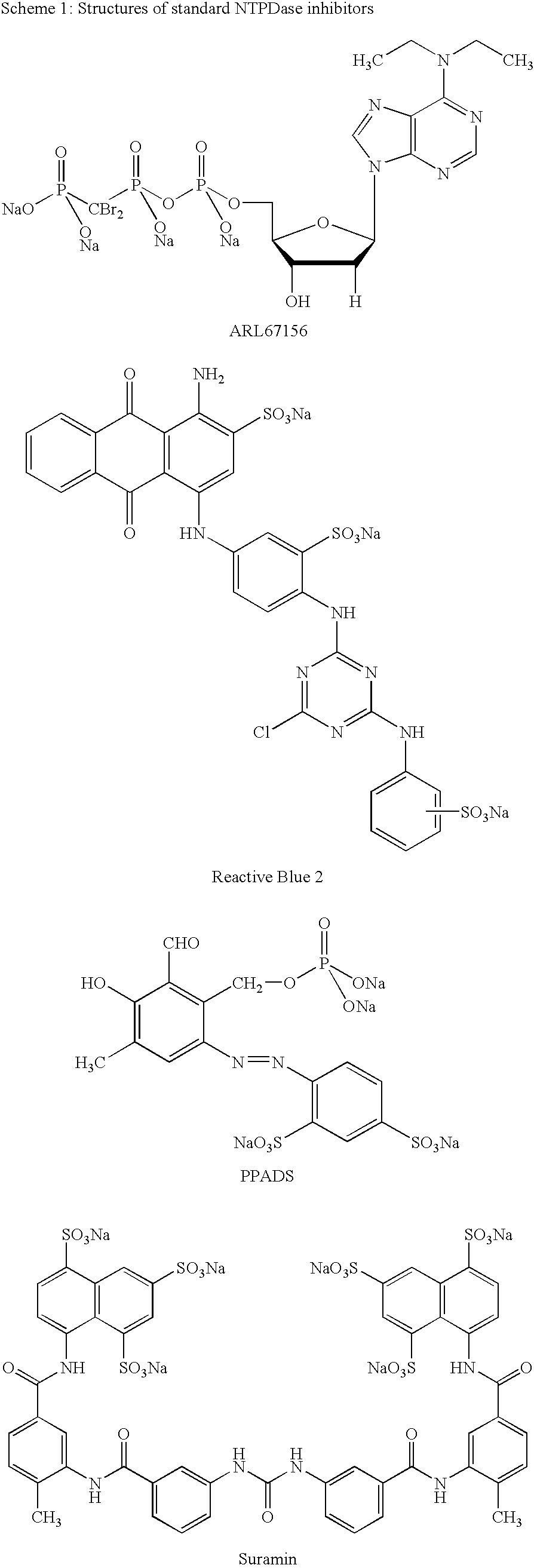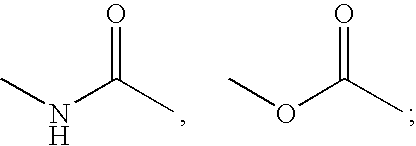Ectonucleotidase inhibitors
a technology of ectonucleotidase and inhibitors, which is applied in the direction of biocide, plant growth regulators, sugar derivatives, etc., can solve the problems of not being highly potent and selectively inhibiting certain subtypes of ntpdases, and achieves metabolically considerably more stable and high potency.
- Summary
- Abstract
- Description
- Claims
- Application Information
AI Technical Summary
Benefits of technology
Problems solved by technology
Method used
Image
Examples
example 1
Synthesis of the Ectonucleotidase Inhibitors and Comparative Compounds (CC)
A. 4-[(2S,3R,4S,5R)-5-(2,4-Dioxo-3,4-dihydropyrimidin-1(2H)-yl)-3,4-dihydroxy-tetrahydrofurane-2-carboxamido]benzylphosphonic acid diethylester (1)
[0047]
[0048]Under an atmosphere of argon, 2′,3′-anisylideneuridine-4′-carboxylic acid (1 mmol, 376 mg), PyBOP® (1.1 mmol, 572 mg) and 1-hydroxybenzotriazole (1.1 mmol, 149 mg) were dissolved in 2 ml of dry DMF at r.t. Diisopropylethylamine (1.1 mmol, 143 mg) and, after one minute, aminobenzylphosphonic acid diethyl ester (2 mmol, 1215 mg), dissolved in 2 ml of dry DMF, were added sequentially via a syringe to the solution. Vigorous stirring was continued for 24 hours at ambient temperature. The volatiles were removed in vacuum at 40° C. and the residue purified by silica gel column chromatography using dichloromethane:methanol (40:1) as an eluent. The product was isolated by rotary evaporation at 40° C. and recrystallized from diethyl ether.
[0049]Deprotection of th...
example 2
NTPDase Assays by Capillary Electrophoresis (CE)
[0253]The applied enzyme inhibition assay has been described (Iqbal J, Vollmayer P, Braun N, Zimmermann H, Müller C E. A capillary electrophoresis method for the characterization of ecto-nucleoside triphosphate diphosphohydrolases (NTPDases) and the analysis of inhibitors by in-capillary enzymatic microreaction. Purinergic Signalling 2005, 1, 349-358).
[0254]A. CE instrumentation: All experiments were carried out using a P / ACE MDQ capillary electrophoresis system (Beckman Instruments, Fullerton, Calif., USA) equipped with a UV detection system coupled with a diode-array detector (DAD). Data collection and peak area analysis were performed by the P / ACE MDQ software 32 KARAT obtained from Beckman Coulter. The capillary temperature was kept constant at 25° C. The temperature of the sample storing unit was also adjusted to 25° C. The electrophoretic separations were carried out using an eCAP polyacrylamide-coated fused-silica capillary [(30...
example 3
Ecto-5′-Nucleotidase Assay
[0259]Catalytically active recombinant soluble glutathione-S-transferase / ecto-5′-nucleotidase fusion protein was expressed in insect cells using the baculovirus system and purified by affinity chromatography using agarose-coupled GSH as previously described [Servos, J., Reilander, H., Zimmermann, H. Drug. Dev. Res. 1998, 45, 269-276]
[0260]Enzyme assays were carried out at 37° C. in a final volume of 100 μl. The reaction buffer consisted of 10 mM Hepes (2.38 g / L), 2 mM MgCl2 (0.41 g / L), and 1 mM CaCl2 (0.11 g / L), brought to pH 7.4 by adding the appropriate amount of 1-N aqueous HCl solution. The reaction was initiated by the addition of 10 μl of the appropriately diluted enzyme (0.52 μg). The reaction mixture was incubated for 10 min and terminated by heating at 99° C. for 5 min. Nucleosides and nucleotides were stable under these conditions. Aliquots of the reaction mixture (50 μl) were then transferred to mini-CE vials containing 50 μl of the internal stan...
PUM
| Property | Measurement | Unit |
|---|---|---|
| flow rate | aaaaa | aaaaa |
| flow rate | aaaaa | aaaaa |
| pH | aaaaa | aaaaa |
Abstract
Description
Claims
Application Information
 Login to View More
Login to View More - R&D
- Intellectual Property
- Life Sciences
- Materials
- Tech Scout
- Unparalleled Data Quality
- Higher Quality Content
- 60% Fewer Hallucinations
Browse by: Latest US Patents, China's latest patents, Technical Efficacy Thesaurus, Application Domain, Technology Topic, Popular Technical Reports.
© 2025 PatSnap. All rights reserved.Legal|Privacy policy|Modern Slavery Act Transparency Statement|Sitemap|About US| Contact US: help@patsnap.com



